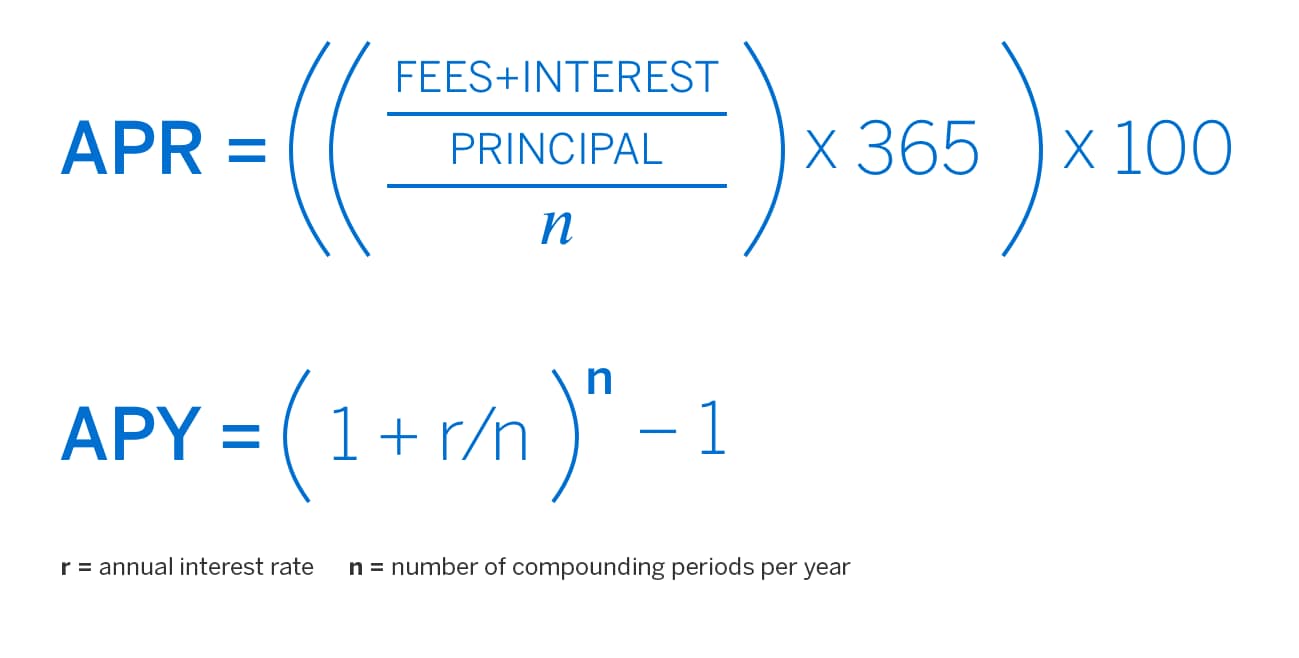The Differences Between APR, APY, and Interest Rates
7 Min Read | Last updated: January 7, 2025
This article contains general information and is not intended to provide information that is specific to American Express products and services. Similar products and services offered by different companies will have different features and you should always read about product details before acquiring any financial product.
APR and APY both include interest rates, but one is mostly for borrowers and the other for investors. Learn more about the differences between APR and APY.
At-A-Glance
- When comparing interest rate offers, it’s important to know the exact meaning of the different rates you are assessing.
- Knowing the difference between annual percentage rate (APR) and annual percentage yield (APY) can be critical to choosing the best interest rate.
- The usefulness of each kind of rate can depend on whether you’re borrowing or investing.
If you’re wading into the waters of borrowing or investing for the first time, you may be hearing unfamiliar terms, such as nominal interest, DPRs, APRs, APYs, EARs, and AERs. Consider the following overview of important differences between interest rates, APR, and APY your life preserver in this alphabet soup.

APR vs APY vs Interest Rate: The Cheat Sheet
Perhaps the most practical things to know about annual percentages rates (APRs) and annual percentage yields (APYs) are the following:
- Both incorporate interest rates.
- APRs are used primarily by borrowers to view the real cost of a loan or other debt.
- APYs are used primarily by investors to view the actual yield of an investment.
That difference in the purpose of APRs vs APYs leads to their other main differences:
- APRs incorporate a loan’s interest rate charge, fees and any other “fine print” costs and express it all as an annual percentage of the loan’s principal—the amount you borrowed.1 You can see those ancillary costs captured in the APR formula below.2

- APYs show the impact on your investment of compounding interest—in other words, your investment’s true yield.3
But if you’re brand new to borrowing or investing, there’s more you need to know to manage the APR vs APY vs interest rate differences outlined above in the real world.
Back to Basics: What is an Interest Rate?
Interest is what a lender charges you to borrow a set amount of money (the principal), usually quoted as an annual percentage. Interest charges are added to the principal, and a borrower must repay the entire sum.1 For detailed information on interest rates and how to compute them, see “How to Calculate Interest Rates.”
Understanding APR
APR is a way of measuring the all-in costs a lender charges a borrower per year. If there are no fees, the APR equals the nominal interest rate. If there are fees, a loan’s APR is its nominal interest charges plus any “fine print” costs, such as:
- Origination fees
- Closing costs
- Monthly maintenance fees
- Guarantee fees
- Check processing fees
APR is shown as a percentage of the loan amount that you pay each year.4 The higher the APR, the more money you will pay back over the life of the loan.
APR can help you decide which loans make the most sense for you by creating a level field to compare total borrowing costs. It helps you figure out whether to choose a financing plan with a higher nominal interest rate and lower upfront fees, or one with some extra fees upfront (such as points on a mortgage) that get you a lower interest rate.5 For more detailed APR information, see “What is APR and How to Calculate It.”
What’s the Difference Between APR and APY for Investing?
Most times you’re looking to maximize interest when you’re investing but minimize it when borrowing. When making a savings deposit or investment, APY may be more helpful, especially for comparing alternatives with different compounding rates.
By way of example, consider two savings vehicles:
- Investment A pays 10% semiannually.
- Investment B pays 10.2% annually.
- Using APR, it looks like Investment B would be a better investment because 10.2% is higher than 10%.
- But the impact of compounding yields an APY of 10.25% for Investment A, making it the better investment decision based solely on earnings.
The Takeaway
When comparing interest rate offers for mortgages, home equity lines of credit, car loans, credit cards, certificates of deposit, or savings accounts, it’s important to know exactly what the rates you are looking at mean. Understanding interest rates and the differences between APR and APY can help you compare rates confidently.
1 “What is the difference between a loan interest rate and the APR?,” Consumer Financial Protection Bureau
2 “APR vs. APY: What's the Difference?,” Experian
3 “Appendix A to Part 1030 — Annual Percentage Yield Calculation,” Consumer Financial Protection Bureau
4 “Knowledge Q: What is annual percentage rate (APR)?,” FDIC
5 “What is an Annual Percentage Rate (APR)? | APR vs. APY,” Equifax
SHARE
Related Articles
How and Why Your Credit Card APR May Change
Curious why your APR (Annual Percentage Rate) changed? There could be a number of reasons APR fluctuates. See some potential reasons for the change.
How to Calculate Interest Rates
Calculating interest rate can be complicated and confusing. Here are a few simple steps to calculate interest rate and credit card interest.
What Is APR and How to Calculate It
Learn what Annual Percentage Rate (APR) is, how to compare different types of APR, and how to calculate it.
The material made available for you on this website, Credit Intel, is for informational purposes only and intended for U.S. residents and is not intended to provide legal, tax or financial advice. If you have questions, please consult your own professional legal, tax and financial advisors.










